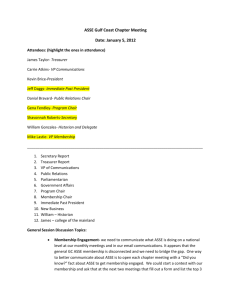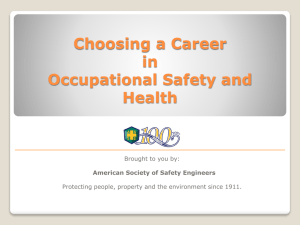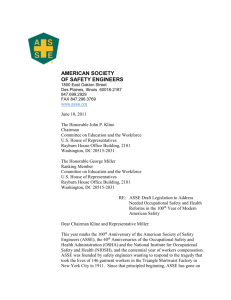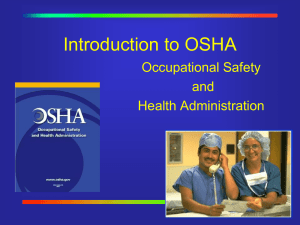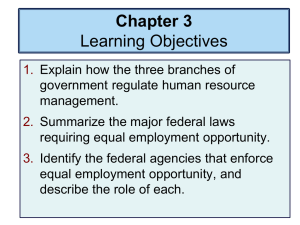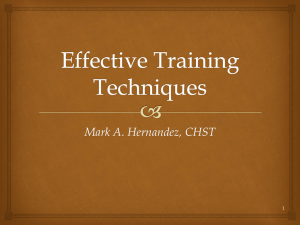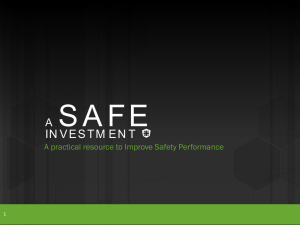April 2011 - Big Sky Chapter - American Society of Safety Engineers
advertisement
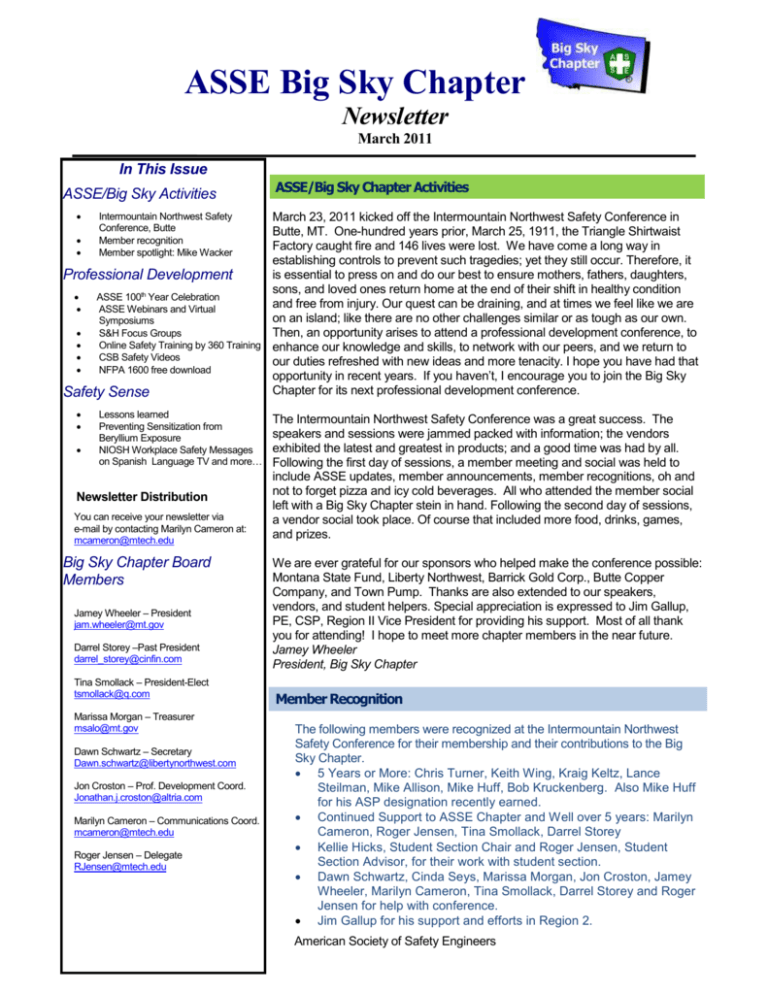
ASSE Big Sky Chapter Newsletter March 2011 In This Issue ASSE/Big Sky Activities Intermountain Northwest Safety Conference, Butte Member recognition Member spotlight: Mike Wacker Lessons learned Preventing Sensitization from Beryllium Exposure NIOSH Workplace Safety Messages on Spanish Language TV and more… ASSE/Big Sky Chapter Activities March 23, 2011 kicked off the Intermountain Northwest Safety Conference in Butte, MT. One-hundred years prior, March 25, 1911, the Triangle Shirtwaist Factory caught fire and 146 lives were lost. We have come a long way in establishing controls to prevent such tragedies; yet they still occur. Therefore, it is essential to press on and do our best to ensure mothers, fathers, daughters, Professional Development sons, and loved ones return home at the end of their shift in healthy condition ASSE 100th Year Celebration and free from injury. Our quest can be draining, and at times we feel like we are ASSE Webinars and Virtual on an island; like there are no other challenges similar or as tough as our own. Symposiums S&H Focus Groups Then, an opportunity arises to attend a professional development conference, to Online Safety Training by 360 Training enhance our knowledge and skills, to network with our peers, and we return to CSB Safety Videos our duties refreshed with new ideas and more tenacity. I hope you have had that NFPA 1600 free download opportunity in recent years. If you haven’t, I encourage you to join the Big Sky Chapter for its next professional development conference. Safety Sense Newsletter Distribution You can receive your newsletter via e-mail by contacting Marilyn Cameron at: mcameron@mtech.edu Big Sky Chapter Board Members Jamey Wheeler – President jam.wheeler@mt.gov Darrel Storey –Past President darrel_storey@cinfin.com Tina Smollack – President-Elect tsmollack@q.com Marissa Morgan – Treasurer msalo@mt.gov Dawn Schwartz – Secretary Dawn.schwartz@libertynorthwest.com Jon Croston – Prof. Development Coord. Jonathan.j.croston@altria.com Marilyn Cameron – Communications Coord. mcameron@mtech.edu Roger Jensen – Delegate RJensen@mtech.edu The Intermountain Northwest Safety Conference was a great success. The speakers and sessions were jammed packed with information; the vendors exhibited the latest and greatest in products; and a good time was had by all. Following the first day of sessions, a member meeting and social was held to include ASSE updates, member announcements, member recognitions, oh and not to forget pizza and icy cold beverages. All who attended the member social left with a Big Sky Chapter stein in hand. Following the second day of sessions, a vendor social took place. Of course that included more food, drinks, games, and prizes. We are ever grateful for our sponsors who helped make the conference possible: Montana State Fund, Liberty Northwest, Barrick Gold Corp., Butte Copper Company, and Town Pump. Thanks are also extended to our speakers, vendors, and student helpers. Special appreciation is expressed to Jim Gallup, PE, CSP, Region II Vice President for providing his support. Most of all thank you for attending! I hope to meet more chapter members in the near future. Jamey Wheeler President, Big Sky Chapter Member Recognition The following members were recognized at the Intermountain Northwest Safety Conference for their membership and their contributions to the Big Sky Chapter. 5 Years or More: Chris Turner, Keith Wing, Kraig Keltz, Lance Steilman, Mike Allison, Mike Huff, Bob Kruckenberg. Also Mike Huff for his ASP designation recently earned. Continued Support to ASSE Chapter and Well over 5 years: Marilyn Cameron, Roger Jensen, Tina Smollack, Darrel Storey Kellie Hicks, Student Section Chair and Roger Jensen, Student Section Advisor, for their work with student section. Dawn Schwartz, Cinda Seys, Marissa Morgan, Jon Croston, Jamey Wheeler, Marilyn Cameron, Tina Smollack, Darrel Storey and Roger Jensen for help with conference. Jim Gallup for his support and efforts in Region 2. American Society of Safety Engineers Big Sky Chapter Newsletter Member Spotlight – Mike Wacker Mike is one of our newest members, a transfer from the Southern Colorado Chapter. He now resides in Columbia Falls, working as the Safety Engineer for Plum Creek Plywood in Columbia Falls and Kalispell, MT. Welcome to Montana, Mike! Mike is a graduate of Texas A & M University with a BBA degree in Business Management. He has worked in the loss control insurance field for 36+ years and has spent 20+ years working for an insurance carrier and almost 16 years in the insurance broker arena. Mike has assisted a variety of clients in their loss prevention and safety efforts including construction, general industry, oilfield, hospitality, transportation and multi-family housing and has assisted clients with their safety and loss prevention efforts thru development of risk prevention programs, conducting site audits, developing and conducting training sessions, claims loss analysis and safety consulting. Mike is a Certified Safety Professional and has been a member of the American Society of Safety Engineers (ASSE) since 11/1/75. He has also been designated as a “Professional Member” by ASSE. Welcome New Members A big welcome to our newest members since Mike Wacker, transfer from the So. Colorado Chapter, now in Columbia Falls Steven Clegg, Cody WY The following are new members of the Student Section at Montana Tech: Matt Curran and Mike Hyman Help a colleague, friend, or associate succeed professionally when you open their eyes to the world of benefits and services the American Society of Safety Engineers provides. Refer a friend, have them put your name on the application as their sponsor; they can take $25.00 off the application fee. You can send them a “ready-made” email right now. Professional Development Opportunities ASSE will be celebrating its 100th year in 2011 in Chicago, IL. Put it on your calendar now: June 12-15, 2011. In honor of ASSE and safety professionals, ASSE wants to hear from you. To submit your story of milestones, best practices, or community influence please visit: http://www.asse.org/100/ ASSE Webinars and Virtual Symposiums Live Webinars May 4, 2011 11:00 AM – 12:30 PM CDT Safety Incentives, Rewards & Positive Reinforcement: Applications to Enrich a Work Culture May 11, 2011 11:00 AM – 12:30 PM CDT Virtual Symposiums View all Webinars Professional Development Seminars Check out http://www.asse.org/education/2011schedule.php for a complete schedule of ASSE seminars. Safety and Health Focus Groups Focus groups are held throughout the state, and most meet monthly with presentations on various safety & health topics. Please visit the Big Sky Chapter’s website for a list of cities, topics, times, and locations. Note that SMASH is being reorganized and will resume meeting soon. The website is in the process of being updated. All sessions are free to the public and no reservations are needed. Employers and employees are encouraged to use these sessions for training and/or informational purposes. Safety committee members and all other persons concerned with improving the safety and health in their workplaces are encouraged to attend. 360 Training 360 Training Courses are available through the Big Sky Chapter Website at http://www.bigsky.asse.org. There are industrial safety courses as well as Human Resources Courses. The online courses are very inexpensive and a great way to get training for you or your employees at the convenience of a computer. Click for a demo: Dealing with Conflict and Confrontation 2 American Society of Safety Engineers Big Sky Chapter Newsletter OSHA issues guide to help small businesses comply with new cranes & derrick rule OSHA now offers a guidance document to help small businesses comply with the agency's cranes and derricks rule published in August 2010. This new standard was issued to address the number of worker injuries and deaths associated with the use of cranes and derricks in construction. Chapters in the Small Entity Compliance Guide for Final Rule for Cranes and Derricks in Construction correspond to sections of the standard to help employers understand what they must do to protect their workers from dangerous, sometimes fatal injuries. This guide accompanies other OSHA compliance materials on crane-related topics available on the agency's Web site including a PowerPoint overview, Web chat transcript, Webinar, list of frequently asked questions and fact sheets. Safety Sense Dangers of Distracted Driving Dangers of distracted driving OSHA's new distracted driving brochure* explains to employers and supervisors the importance of preventing texting by their workers while driving. Texting while driving dramatically increases the risk of motor vehicle crashes, the leading cause of worker fatalities. Distracted driving crashes killed more than 5,400 people and injured nearly 500,000 in 2009. OSHA encourages trade associations to share this brochure with their members. It can be downloaded or ordered from the Publications page of OSHA's Web site. This resource is part of OSHA's Distracted Driving Initiative, which OSHA Assistant Secretary David Michaels discussed with stakeholders in a March 3 teleconference. Participants representing workers, employers, trade associations, insurance companies, small businesses, government agencies and advocacy groups participated in a discussion of strategies and plans to work cooperatively to help inform businesses of the importance of preventing texting while driving. See OSHA's Distracted Driving Web page for more information on the agency's efforts to protect workers from this growing hazard. Faces of Distracted Driving Video Faces of Distracted Driving is a video series exploring the tragic consequences of texting and cell phone use while driving. It features people from across the country who have been injured or lost loved ones in distracted driving crashes. In 2009, nearly 5,500 people died and half a million were injured in accidents involving a distracted driver. The series is part of Secretary LaHood’s effort to raise greater awareness about the dangers of distracted driving. OSHA celebrates 40 years of helping to ensure healthier workers, safer workplaces and a stronger America Throughout 2011, OSHA is presenting a series of resources and activities to celebrate the agency's 40th anniversary. Visit the OSHA at 40 Web page for an interactive timeline of the agency's history, an anniversary message from OSHA Assistant Secretary David Michaels and a commemoration of the Triangle shirtwaist factory fire. Occupational Health Nurses and Safety Do you recall having a job description that focused on a single area of responsibility? With today’s challenging business environment, responsibilities have increased for most environment, health and safety (EHS) professionals. The role of the occupational health nurse is no exception. Certified Occupational Health Nurses (COHN) and Certified Occupational Health Nurse-Specialists (COHN-S) demonstrate professionalism and competency on a daily basis. Certified OHNs impact business decisions in various business sectors. Companies who employ these highly trained and skilled professionals often look to the OHN for leadership; not only in the occupational health, treatment and wellness arenas but also in accident/injury prevention. Because of their unique background and skills, OHNs are a natural fit for safety! In fact, many occupational health nurses have responsibilities in areas that fall within the safety arena. Examples include responsibility or oversight for: OSHA recordkeeping. Conducting accident investigations/root cause analysis and recommending corrective and preventive actions. Personal protective equipment (PPE) hazard assessments. Assisting with respiratory protection: selection, fit-testing and training. Performing noise area monitoring/ personal sampling to determine exposure; recommending engineering or administrative controls to reduce that exposure and assisting with PPE selection and training. Conducting ergonomic assessments to identify hazards, assess risk and recommend control methods (following the 3 American Society of Safety Engineers Big Sky Chapter Newsletter hierarchy of controls) to reduce risk to tolerable levels. It makes sense for those occupational health nurses who work in safety to demonstrate professionalism, expertise and competency. For safety professionals, this means qualifying for credentialing such as the Associate Safety Professional (ASP), Certified Safety Professional (CSP) or Occupational and Safety Technologist (OHST) offered through the Board of Certified Safety Professionals (BCSP). To promote the same level of professionalism in safety for occupational health nurses, the American Board for Occupational Health Nurses (ABOHN), partnered with BCSP to develop the Safety Manager (SM) professional safety specialty credential. Safety Manager (SM) – Professional Safety Specialty Credential The Safety Manager credential (SM) is the premier safety specialty credential offered by the American Board for Occupational Health Nurses (ABOHN). Achieving the SM credential reflects expertise and competency of the OHN with safety responsibility. To qualify to sit for the board certification exam, applicants must: hold the core credential (COHN or COHN-S), earn fifty contact hours related to safety, demonstrate work experience related to safety domains and have a minimum of 25% of safety responsibilities in their job. The SM credential: Is the same level as the Associate Safety Professional (ASP) offered by the BCSP. May serve as a terminal certification (does not expire if renewed-CEU requirements are applied). Is accepted by the BCSP for qualification to sit directly for the Certified Safety Professional (CSP) professional certification. If you are an OHN with safety responsibility or have an OHN working for you who does, the SM specialty credential is essential to demonstrate competency! For more information, visit the ABOHN website at www.abohn.org. This article is from a guest writer, Peggy Ross, RN, MS, COHN-S/CM/SM, COHC, CSP. Peggy has worked in the occupational health and safety field for over 20 years. She is currently an EHS manager for corporate occupational health and safety at Baxter Healthcare Corporation. Her focus is on safety, ergonomics, non-regulated fleet, case management and occupational health. She has presented at various national conferences and been published in Professional Safety and the AAOHN Journal on a variety of topics. She is currently serving on the American Board for Occupational Health Nurses, Board of Directors. She is scheduled to present Session number 644 at the upcoming ASSE PDC in Chicago. ISEA announces update of hand protection selection consensus standard An updated standard designed to help in the evaluation and selection of adequate hand protection for specific applications has been published by the International Safety Equipment Association (ISEA). The standard called American National Standard for Hand Protection Selection Criteria (ANSI/ISEA 1052011) aims to assist users and employers in the appropriate selection of gloves for identifiable workplace hazards that could result in chemical burns, severe cuts and lacerations, and burns caused by heat and flame exposures. Like previous editions, ANSI/ISEA 105-2011 uses a numeric rating scheme for classifying hand protection against a variety of performance assessments. Updates reflected in the current edition focus on distinct test methods to determine a gloves’ abrasion resistance depending on the material type, and cited test methods to ensure they represent the state-of-the-art in materials performance and technology. Perhaps the most notable update to the standard is the acceptance of different ASTM methods for evaluating cutresistance performance. Some studies show that nearly 20 percent of workplace injuries involve cuts and lacerations to the hand and fingers, prompting ISEA members to focus on ways to provide meaningful information in this critical area. To this end, the updated document includes a standardized template for use in classifying gloves specifically designed to protect against cuts. Educating users on how to use the data in the selection process will be key, according to ISEA. For more information, visit www.safetyequipment.org OSHA Issues Guidance on Spirometry Testing to Prevent Respiratory Hazard Exposure OSHA and the National Institute for Occupational Safety and Health (NIOSH) developed two guidance documents, one for workers and one for employers, describing the use of spirometry testing to help reduce and prevent worker exposure to respiratory hazards. 4 American Society of Safety Engineers Big Sky Chapter Newsletter Spirometry is a common pulmonary function test that measures how well a person moves air in and out of the lungs. Workers who inhale some types of dusts, gases or other air contaminants can, over time, experience lung damage. The spirometry test may detect breathing problems or significant changes in a worker’s lung function at an early stage. “Spirometry is the best available test for early detection of decreasing or abnormal lung function,” said OSHA Administrator Dr. David Michaels. “Our joint effort with NIOSH in developing these products will help broaden outreach and enhance knowledge of preventive measures aimed at protecting worker health and safety.” The Documents The information in these new guidance documents assists employers with identifying and eliminating hazardous workplace exposures and helping reduce or prevent the chances of workers developing lung disease. The new guidance document for employers clarifies what spirometry is, when it is needed and critical elements that employers can use to evaluate the quality of spirometry services provided to their workers. It also describes how monitoring workers’ lung function over time can help individuals by identifying problems early and make the workplace safer by identifying when workplace respiratory hazards are causing problems that must be corrected. The companion document, OSHA-NIOSH Worker Info, explains to workers the importance of taking a spirometry test, what to do during the test and their right to receive an explanation and copy of test results. “We are pleased to join with OSHA in emphasizing the important role of spirometry in preventing costly, debilitating and potentially fatal occupational lung diseases,” said NIOSH Director John Howard, M.D. “These tests are a vital component of health and safety programs in workplaces where workers may be exposed to hazardous airborne contaminants.” OSHA also recommends spirometry testing for workers exposed to diacetyl and diacetyl substitutes. The agency recently issued a safety and health bulletin, Occupational Exposure to Flavoring Substances: Health Effects and Hazard Control, and a companion Worker Alert on Diacetyl and Substitutes. These documents recommend that employers include spirometry testing in their medical surveillance programs to identify workers experiencing adverse health effects from exposure to flavorings, including food flavorings containing diacetyl. Share the Safety We are soliciting ideas and articles for the next issue of the Big Sky Chapter newsletter. Do you have a technical article you would like to share? Have you solved a problem that would benefit others? Do you have a success story that we could all learn from? Are you offering a class that others might be interested in? Anything that would be of interest to our members? Please send any articles, notices, etc. to Marilyn Cameron, mcameron@mtech.edu, before April 15 for inclusion in the newsletter. We look forward to hearing from our members. Advertisements ASSE has promotional items available for purchase from its members. Check out the awards store to help you provide recognition for a job well done! Looking for a job? Nexsteps has some newly posted vacancies. NEW - Safety Resources Catalog Choose from a wide variety of technical publications covering every facet of safety –from accident investigation, to BCSP exam preparation materials, to the best in safety management. ASSE is certain to have the resources needed for any SH&E professional. It also offers a full collection of standards available in both hard copy and electronic copy. http://viewer.zmags.com/publication/0bf7e8ed#/0bf7e8ed/ 1 . 5 American Society of Safety Engineers
